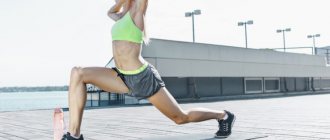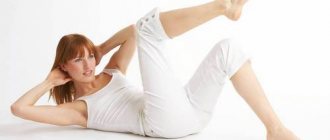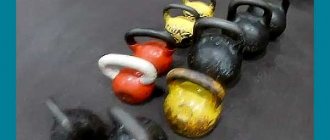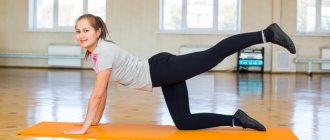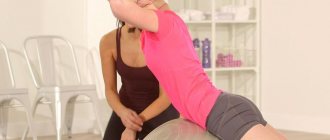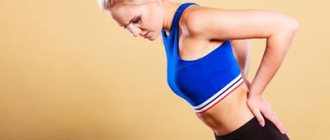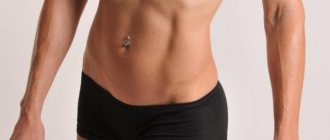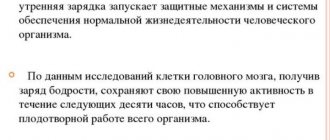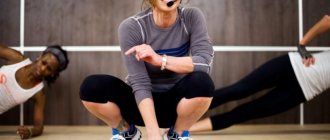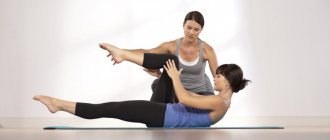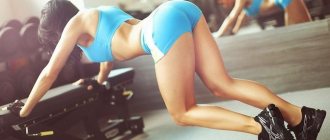Why do you need to prepare for skiing?
Skiing is quite specific. Full training for a skier requires specific conditions: ski slope, snow (artificial or natural), and equipment. But this does not mean that preparation is carried out only in a certain season.
To stay fit, skiers perform a series of exercises that develop certain skills (for example, coordination, strength, balance and speed, endurance, etc.). There are options for performing exercises for skiers both at home and in specially equipped gyms.
When performing movements, dumbbells and weights, a barbell, treadmills and special equipment are used that simulate skiing, moving uphill and under various conditions, and so on.
https://youtu.be/N4AyTKkpxXE
Ski training is necessary for the following reasons:
- Additional movements help keep your weight normal. This point is especially important for those athletes who are struggling with excess weight, since in addition to diet, it will be effective to include various exercises in the regime.
- Physical training helps keep muscles toned. If an athlete does not train for a year, athletic performance will deteriorate.
- Preparation throughout the year will help improve results by developing the right muscle groups.
- Lack of training throughout the year can cause weak blood vessels and joints, which will affect the season. This approach is fraught with the development of occupational diseases and injuries.
Even exercises for skiers without skis are possible. The athlete must keep himself in shape and develop certain skills and muscles, then the main training season will be more effective.
Exercises for skiers before hitting the slope
Immediately before skiing, it will be a good idea to warm up and warm up your muscles. You can do this simple set of exercises:
- 10-15 circular rotations of the head to the left and right sides.
- 10-15 swing arms forward and backward.
- Stand up straight, leaning on your ski poles. Next, the sticks remain in place, and we ourselves move back a little. The final position is to hold on to the sticks and keep your torso in a horizontal position. We stand and stretch for 20-30 seconds.
- We alternate doing lunges with our legs, holding on to our ski poles. One leg is bent at the knee joint, the other is laid back. We stretch the muscles of the front surface of the thigh for 10-15 seconds.
- Standing straight, without skis, leaning on ski poles, we swing our legs back and forth. Alternately with each leg 10 times.
- Let's get on our skis. We lean forward without bending our legs. We reach with our fingertips to the toes of our shoes. We stand in this position for 10-15 seconds, after which we gradually move our hands towards the toes of the skis; the further the better.
Home exercises for skiers
Many people are interested in how skiers can train in the summer, as well as in the spring and autumn, that is, in the off-season, if expensive equipment, conditions and ammunition are not available? Of course, a professional athlete needs different exercise equipment, as well as more frequent trips to the track, but amateurs just need to keep themselves in shape, for which home workouts are enough.
Home exercises for skiers fall into two categories: equipment-requiring or equipment-free. The first ones are performed in any conditions; no preparation is required. It is worth highlighting the following exercises for skiers without skis:
- Warm up. This could be general stretching or light bodyweight strength training (such as squats or push-ups). Performed daily, for example, as exercise.
- Cardio load. Interval running, walking, Nordic walking (ski poles are used when walking), skipping rope, and so on are effective.
- Special movements that affect coordination and balance. Any set of home exercises should include similar movements.
- Special exercises on rollers. They create an imitation of skiing movements: various types of moves (skating, classic). Roller skating allows you to skate almost like ice skating, which helps develop the same muscles that are used when skiing, plus additionally develops coordination and balance.
If you have some equipment, you can train more effectively. The skier will include strength movements in the program, which will allow the development of important muscle groups.
Learning to keep balance
Balance is important for a skier, regardless of his specialization. This is taught from the very beginning. So, any child, even a preschooler, begins training with such exercises.
First of all, the athlete must acquire basic coordination skills. To do this, perform squats on one leg, as well as raising legs to the side. When the exercises become easy to perform, you can begin to perform the same movements, but using a hemisphere or platform, which are also used in fitness.
Flexibility and stretching
Any racer using skis should pay special attention to muscle stretching and flexibility. To develop such skills, you will not need to purchase expensive equipment for your home gym; it will be enough to do some basic training.
First of all, it is worth considering basic stretching exercises: bending, swinging, and so on. You should stretch not only the leg muscles, as with the splits, but also pay attention to your back, especially the lower back, and other groups. This will reduce the risk of injury, reduce the risk of sprains and increase joint flexibility.
It is recommended to stretch before each workout or at the end of it. You can perform such gymnastics both in a specially equipped room and at home, since no special conditions are needed.
Strengthening the abs and back
Training the back and abs is important, as these muscle groups keep the body in balance, and a developed muscle corset protects against injury. When performing, you can use various equipment, for example, weights, dumbbells, barbells, horizontal bars, and also perform exercises with your own weight.
It is worth highlighting several basic exercises:
- Hyperextension. A special exercise to develop the lower back. To perform this you need a special simulator.
- Bent-overs with a barbell or dumbbells. Also strengthens the lower back.
- Deadlift. The exercise should be performed carefully, increasing the load gradually, otherwise there is a high risk of spinal injuries, including hernias.
- Exercises on simulators, for example, rows of the lower block, upper block, and so on.
- Standard abdominal exercises, such as crunches, planks, hanging leg raises, and so on.
It is recommended to draw up a training plan and strictly follow it. This is the only way to achieve the highest results. Planning is important both in the winter and in the off-season, when specialized training will not be available.
How the legs work (anatomy)
In principle, we talked about this in the previous article, but it’s still worth briefly repeating it again. To know how to change and develop something, you need to know how it works. So.
It’s only worth worrying about three places, if we’re talking about legs:
- Quadriceps femoris (quadriceps femoris) – extend the leg at the knee joint; The largest muscle in the body is located in front of the legs.
- Biceps femoris (biceps femoris) – bend the leg at the knee joint; are located behind the legs, under the butt.
- Shin (calf + soleus) – lifts you onto your toes; located behind the leg, under the knee.
Muscles are attached to bones by tendons. I don't think this is new to you. In the center of the leg we have a knee joint. From above it comes the strongest bone in our body - the femur (capable of withstanding a vertical load weighing as much as a Kamaz truck). Below the knee there are two bones - the tibia (large and small). On the joint itself is the patella (kneecap) to protect it.
Bones, in order to move relative to each other, are connected to hinges (joints).
A joint is a hermetically sealed cavity (bursa) filled with synovial fluid (lubricant) to reduce friction and wear of cartilage.
For us, the most important joints that are involved when training legs, from top to bottom, are:
- Hip joint (moves the thigh relative to the pelvis)
- Knee joint (moves the thigh relative to the lower leg)
- Ankle joint (moves the foot relative to the lower leg)
Now let's note the most important thing. quadriceps – extend the leg at the knee joint, have four heads (lateral, medial, rectus and intermediate), and are the largest and strongest muscles in the legs.
The hamstrings are located at the back of the legs (from the butt to the knee joint). They have two heads (long and short). They have two main functions: bending the leg at the knee and the second (which will help us understand the training) is extension of the torso with the shin fixed (the load is divided between the biceps and gluteal muscles).
To develop powerful hamstrings, it is important not only to bend your legs (in the simulator), but also to straighten your torso, fixing your shins, i.e. perform various lifts (deadlifts, deadlifts, etc.).
Now the shin! It is located at the back of the leg, below the knee, and there are two muscles of interest to us: the gastrocnemius (two heads, located on top) and the soleus (one head, located under the gastrocnemius). There is one important nuance: the gastrocnemius works when the knee is straightened, and the soleus works when the knee is bent, so the calves must be pumped both while sitting and standing.
Leg workout
Developed leg muscles are important for a skier, since the main load will be placed on the legs. The athlete needs to choose a set of exercises depending on his riding style, preferred distances, and so on. For example, skiers who prefer marathons should do more endurance exercise. Thus, performing squats without weight or with a small load will be more beneficial than squats for a small number of repetitions, and the sprinter should choose stronger options.
Special exercises are also used, each of which is used to develop certain qualities. These movements are rarely used in other sports, as they are highly specialized.
Various gymnastics and fitness will be most useful in those months when it is not possible to train directly on the slope (for example, May or July are characterized by heat and not all regions have the opportunity to train directly on the mountain slope).
Twist
The twist is a specialized exercise for skiers that helps with leg development. This is done as follows:
- Starting position - legs together, feet at a small distance, arms slightly bent and lowered along the body.
- The athlete squats deeply, to parallel or below. In this case, the knees are directed alternately to the right and left. Your arms should be pointing in the opposite direction to your legs.
- The body returns to its original position, each foot should be on the floor without lifting off.
Extending your knees to the sides should be done carefully; additional weights are not used, at least at the first stage. The exercise partially simulates the load that falls on the skier during the descent.
The risk of injury will be minimal, but it is still recommended to start the exercise with a warm-up.
Pistol
A pistol is essentially a one-legged squat. They allow you to develop not only strength, but also coordination. It is performed in the same way as regular deep squats, but one leg must be pointed forward. At the initial stage, you are allowed to hold on to the wall with your hand.
Knee raises forward
This exercise helps develop both leg strength and endurance. This is a simple walk, only the legs are raised high, the knees touch the body.
This method will be more effective when using weights, but everything will depend on the athlete’s goals.
Ski training equipment
Skis and roller skis
Used during endurance training, intervals of varying intensity, speed work, recovery and, of course, competitions. For special strength work, skating without poles, without the use of legs (simultaneous stepless walking or doublepoling), or skating with one pole is practiced.
Running and cycling
Used for developing endurance, intense and speed training, recovery and competition.
Imitation
Stepping imitation is used to develop endurance, strength, and intense training.
Jumping simulation - for intensive training, strength, speed.
The simulation can be performed with or without ski poles. The movements repeat those of the classic alternating stroke. Simulation poles should be about 5cm shorter than your regular classic ski poles.
Imitation walking can be incorporated into running workouts by using it as intervals on steep and/or long inclines.
When performing a jumping imitation, in order to improve strength and explosiveness, take short intervals, push off powerfully, trying to make each step as long as possible. During interval work, try to maintain the intensity, rhythm and push-off force of a cross-country ski race.
Plyometric (jumping) exercises
Used to develop explosive strength.
Perform jumps in series of 10-15 jumps, trying to make each jump as long as possible. Rest between sets for 2-3 minutes. To skate, jump from side to side (from one foot to the other) either in place or up a steep incline. For the classic move, jumping with one foot pushing up the slope of a steep climb is performed, or jumping with both legs at the same time also uphill. You can come up with different variations of jumps, the main thing is to warm up properly before such exercises.
Gym
Lifting weights in the gym is used to train maximum strength, as well as balanced development of all muscle groups. Do exercises on different machines to maximize the use of a variety of muscles.
Circuit training
Used to train strength endurance and balanced muscle development.
Choose a set of several exercises for the abdominal muscles, back, legs and arms. Perform each exercise for 30-90 seconds and then immediately move on to the next exercise - without rest.
Training the arms, chest muscles and shoulder girdle
Training other muscle groups is also worth paying attention to. The muscles of the arms, chest, and shoulder girdle will be important. Such movements will affect the appearance of the athlete.
Visiting the gym will be effective, but it will be enough to do home exercises, for example, push-ups, exercises with dumbbells, and so on. Even with home training, a program is needed, since violation of the regime will reduce efficiency, and performing exercises in accordance with a given plan will minimize the negative consequences and increase the impact of the training process.
The result was an excellent video about home freeride
0
Source:
0
Source:
https://youtu.be/_HrIVWziJ0Y
It took Philip a whole day to create the video. He rearranged the furniture, set up the camera, suited up and started filming. The filming itself took six hours, and another four hours were spent editing the video - mainly on sound (to create the feeling that it was really happening somewhere in nature).
Strength training for experienced skiers and snowboarders
A novice athlete can easily get by with general physical movements, exercises for posture, and endurance. It is important to monitor your technique and pulse. A more experienced athlete, who has completed more than one competition, has been training for more than a season, selects more complex exercises.
Important! For full-fledged training, a fitness bracelet with a heart rate measurement function will be an indispensable assistant. You can see prices for such gadgets in this online store
Statistics show that strength training will be beneficial. What is important here is not general physical education, which is limited to a young skier at the initial stage of training, but heavy strength exercises.
It is best to prepare either in the gym or at home, if you have some equipment. At the same time, other goals must be taken into account, for example, losing weight will require more extensive cardio exercise while following a special diet, and gaining weight will require strength exercises and increased caloric intake.
Rule! Many skiers incorporate general strength exercises such as squats, deadlifts, and pull-ups, but also perform specific movements.
Where Piglet and I are going is a big, big secret!
The target for the mass ski race was to be the village of Verkhniy Idel.
At the beginning of March, Finnish skiers from the long-range reconnaissance company of the 14th division checked the route of the future raid and even reached the village itself - but almost fell into the hands of Soviet border guards and were barely able to break away from the chase. Now this detachment was to become guides for the entire battalion.
Finnish skier on the march (photo source)
On the occasion of the raid to the rear, the soldiers were given a packed ration for six days, which included 20 grams of chocolate, seven sweets and as many as eight cigarettes. Each platoon had two drags loaded with explosives and incendiary bombs. In total, the Finnish detachment had 24 such drags - this supply allowed us to hope for a serious fireworks display, although not on New Year's Eve.
A set of coordination exercises
Coordination is one of the most important skills a skier needs. Its development should be dealt with from childhood, since it is during this period that the return from classes will be maximum.
To develop coordination, exercises are performed on stabilizer muscles. Various gymnastic apparatus are suitable for this, for example, special hemispheres or balancing platforms.
Experienced athletes also use a sling stretched between two supports. From a certain point you can go to the rope. Many skiers go to the forest for this, but you can equip an appropriate training area at home or in another place.
Ski training periods throughout the year
Transitional recovery period (spring)
A physical, emotional and mental break from the busy winter training and racing season. It is even possible to give up physical activity completely, but active rest will be much better.
Base period (summer)
The base period is so called because it is the foundation on which the training of subsequent periods will be built.
Endurance:
Aerobic endurance is the primary component of cross-country skiing and takes the longest to develop. Developing endurance is the top priority for the foundation period. Endurance training example: 2 hours of rollerskiing or running in intensity zone 1 or 2, or 3 hours of cross-country cycling in intensity zone 1 or 2. 80% of your training time should be devoted to developing endurance. The rest of the training is strength training, interval training, and competition.
Force:
General Fitness: Power and strength endurance are based on maximum strength. General physical training strengthens muscles and ligaments, preparing them for the training that will follow later. General physical fitness is a priority during the spring and summer. Example: After 5-6 weeks of training all muscle groups in the gym, start doing low reps with heavy weights on specific muscle groups.
Specific strength training: Developing the strength of specific muscles involved in skiing becomes more important in late summer and fall, after a period of general strength development. Example: long-term double-poling training on very rough terrain.
Intensity:
Until mid-summer, the vast majority of training should be in intensity zones below the PANO. Short bursts of speed are possible, but heavy aerobic and anaerobic intervals should be kept to a minimum during this period. An example of a possible workout: intervals of 2 to 10 minutes at a pulse approximately 5 beats below the PANO level; 2 minutes rest between intervals. Start with 1-2 such workouts per week.
Technique and speed:
Speed training at this stage should not be strenuous, it is recommended to perform short speed segments with full recovery in between. The main focus of speed work is technique and coordination of movements at high speed. Example: Perform 10-20 second bursts of speed during endurance training.
Pre-competition period (autumn)
Training is becoming more specific to the movements and intensity of cross-country skiing. Aerobic endurance is still a key priority, but the means of developing it are becoming more specialized and more intense.
Endurance:
Training volumes are leveled off or even reduced slightly to allow more high-intensity training to be included in the plan. The majority of training volume is aerobic endurance development, low-intensity training that is moderate to long in duration. Example: training on roller skis or running almost entirely in intensity zone 1.
Force:
General physical training takes a back seat to special strength. For 4 weeks, make maximal strength development a priority. Of course, strength endurance is most important for skiers, but maximum strength and power should not be neglected. Example: bodyweight circuit training. Try to include more exercises on the muscles used when skiing.
Special strength: the basis of strength training is training on roller skis, and for quite a long time. Also, skiers' training at this stage should include plyometric, explosive jumping training. Training example: 10 accelerations of 200 meters each at the same time, 10 accelerations of 200 meters alternately; the remaining (sufficiently long) training distance is done simultaneously.
Intensity:
During the pre-competition period, the intensity of “intensive” training gradually reaches the competitive level. For this purpose, high-intensity intervals are used (at ANSP and higher - at the MPC level). In order for such training to be effective, it is necessary to perform a sufficient number of repetitions. An example of training at the PANO level: a series of intervals lasting 2, 3, then 5 minutes, with a rest equal to the time of the interval. Complete 3 such series. At the end of each interval, you should feel like you could have continued the movement, and at the end of the workout, you should feel like you could have done more reps. An example of a high-intensity workout at the VO2max level: 5 x 5 minutes at a heart rate of 95% of the maximum heart rate (this heart rate level should be reached no earlier than during the second interval), the rest period is equal to half the time of the working interval. You should cover approximately the same distance during each repetition.
Technique and speed:
During all training, pay increased attention to skiing technique. Speed training is a great opportunity to train anaerobic capacity, but also trains the ability to ski technically and relaxedly at close to top speed. Example workout: 10-20 20-second bursts of “maximum” acceleration during an endurance workout.
Pre-competition period (first snow)
The transition to snow skiing requires a decrease in training intensity due to the increasing volume of training for skiing. Example: long-term endurance training on skis, strictly in intensity zone 1. More intense training is better done using training tools other than skis.
"Decembrists":
Skiers who don't monitor the intensity of their training often ramp up their training load too quickly. This results in a short-term spike in their fitness and performance, followed by a long period of decline. Such skiers are sometimes called “Decembrists” because they show good results only at the beginning of the competitive season.
Competitive period
A good foundation and a well-managed pre-competition period will provide you with a high level of physical readiness and the ability to consistently perform well in competitions throughout the season. A well-trained skier can endure a series of targeted races or even several race series with consistently high performance.
Series of "regular" races
Endurance:
Training volumes are greater than during a series of key races when volumes are reduced (see below). Example: 1.5 hour workout mainly in intensity zone 1
Interval training:
It's important to strike a balance between competing and interval training, but don't neglect intervals, especially early in the competition season. Be careful with your midweek intervals if you're starting every week - make sure you have time to recover. Example - intervals near PANO: 3 intervals of 7 minutes with a heart rate 5 beats above the PANO pulse level, rest 3 minutes between repetitions. At the end of each interval, you should feel like you could have continued the movement, and at the end of the workout, you should feel like you could have done more reps. An example of high-intensity intervals is at the level of maximal maximal resistance: 2 series consisting of 3, 4, then 5 minutes of work at 95% of the maximum heart rate, the duration of rest is equal to the time of the working interval. You should cover approximately the same distance during each repetition.
Speed:
It is important to systematically perform speed training; Alternatively, they can be included in long or interval training.
Force:
Specific Strength: To ensure continued strength gains, it is important to regularly perform specific strength training on skis - just like you did on roller skis in the fall.
General Fitness: Circuit training will help maintain maximum strength and power levels, as well as balanced development of all muscles. Example: Bodyweight circuit training targeting all muscle groups.
Race:
At this stage, racing results are secondary; Getting in shape and improving technique through participation in competitions is more important.
Series of key races
Endurance:
Training volumes decrease. At the same time, the frequency of training can remain the same so that you do not feel overstayed. Examples: If you decide to maintain the number of training sessions, reduce the duration of endurance training sessions. If you are ready to reduce the number of workouts, then leave their duration the same.
Intensity:
Physical fitness has already been gained, intervals are now needed in order to feel sharpness and vigor, and not to gain physical condition. Example workout: 3 x 3 minute intervals just below the TARP level with recovery equal to the duration of the interval, then 2 x 2 minutes at an intensity slightly above the TARP (recovery time again equal to the time of the working interval) and at the end 4x30 seconds at a maximum with full recovery between repetitions.
Speed:
Same approach as with intervals
Force:
Minimum training to maintain your strength level, or no strength training at all for this period.
Race:
Focus on achieving your goals for the race and showing maximum results.
Note: Sometimes it is useful (contrary to traditional recommendations) to increase training volumes while keeping the intensity very low. It may be better to do this using other methods of training: running, cycling, etc. - this will help keep the “ski” muscles fresh. You need to know your body well to know what works best for you.
Original article
Translation - Olga Polyakova
Roller ski training with STRELA trainers - sign up by phone 8 915 481-1655
Subscribe to our Telegram channel (@strela_coach) and read new articles!
Jumping and special exercises
The sports field is developing, new effective equipment and simulators are constantly appearing, including for skiers. Therefore, many special exercises have appeared for skiers that help keep them in shape even in the off-season.
Various jumping exercises that are performed both with your own weight and with weights are effective. For example, a bag containing sand is used as additional weight. This will allow you to more effectively develop both strength and balance.
Jumps can be performed up and long. You can take heavier poles, which also fit through a loop. There are many options.
Roller exercise for speed and strength training
Rollers can be of great help in the off-season, when the use of skis is impossible due to weather conditions. Any roller skater has more opportunities to develop ski skills, since they constantly use the same muscles and similar skills.
It is important to use high-quality rollers, as otherwise you can get injured or, at best, rub your feet, most often your little toe. High-quality equipment will not let you down like that.
Skiers can not only roller skate, but also perform various special training. For example, train a certain type of move, work on endurance or speed, move uphill or downhill, and so on.
Skiers can train not only on the piste. There are exercises that allow you to keep yourself in shape and develop certain muscle groups and skills. All this is important to achieve results, as well as to minimize injuries, which often occur in unprepared athletes. You can even train at home, especially at the initial stage or at an amateur level.
Everything is fine, beautiful marquise!
The battalion reached the Soviet village at dawn on March 16. In addition to Upper Idel itself, the rear units of the 27th Infantry Division in the area of the 16th and 21st kilometers of the Reboly-Kochkoma highway were attacked.
If you believe the brochure subsequently compiled by the headquarters of the Karelian Front, then the Finns were able to accomplish almost nothing.
“The enemy managed to approach the outskirts of the village from the south and southeast and set fire to several houses. Having encountered heavy fire from the garrison and suffering losses (12 killed and 12 wounded), the enemy was forced to withdraw, leaving 3 killed on the battlefield. The detachments that went out on the road 16 and 21 km managed to commit minor sabotage and break communications. The task of destroying the village was not completed.”
In reality, everything was far from so good. For example, in the area of the 16th km, the Finns burned the engineering warehouse of the 27th division, and also broke and set fire to part of the Rugozero railway line. Also very lucky was the sabotage detachment, whose target was the auto repair shop of our 27th division. The report telling about this is very similar to the complaint of the “robbed Shpak” from the famous Soviet comedy.
“As a result of a surprise attack, the enemy managed in this area to burn down a workshop building with all the tools and equipment, 3 ZIS-5 vehicles, a type B workshop, one anti-aircraft machine gun vehicle and up to 20 different wooden buildings, using thermite time bombs."
